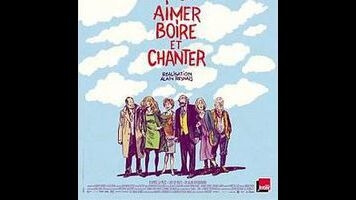The subject is death, at least in part. The unseen George Riley has been diagnosed with terminal cancer, and the news—as well as the months of illness that follow—affects his circle of well-to-do friends, forcing to them to take stock of their lives and their relationships to one another. The cast is made up of three couples: Jack (Michel Vuillermoz) and Tamara (Caroline Silhol); Colin (Hippolyte Girardot) and Kathryn (Sabine Azéma, Resnais’ widow); and Riley’s estranged wife, Monica (Sandrine Kiberlain), and the man she left her husband for, Simeon (André Dussollier).
In many ways, the movie plays like a lesser counterpart to Resnais’ previous film, You Ain’t Seen Nothin’ Yet, which now seems like the more fitting swan song, both more accomplished in its interplay of forms and more succinct in the way it summarizes the ideas and approaches of the final three decades of the director’s career. Both films deal with a group of actors brought together by the death—or, in Riley’s case, the impending death—of a mutual friend. Both also nest an adaptation of one play within an adaption of another by the same author. In You Ain’t Seen Nothin’ Yet, the plot of Jean Anouilh’s Dear Antoine: Or, The Love That Failed is used as frame a staging of Anouilh’s earlier play, Eurydice; in Riley, which was adapted from Alan Ayckbourn’s play of the same title, the characters are members of a community troupe that is putting on a production of Ayckbourn’s first hit, Relatively Speaking. (This self-referential device is part of Ayckbourn’s original play.) Like Riley, the director of the troupe remains unseen.
Resnais’ decision to preserve the play’s Yorkshire setting contributes to the impression of unreality, as does his use of interstitial footage of a real countryside. The end result is that the movie’s conceptual and visual artificiality ends up foregrounding the reality of the narrative: the characters, their relationships, and their feelings. Much of the movie is composed to stagey wide shots, which makes every flourish—say, an abrupt camera movement toward a character—register as a meaningful gesture.
Resnais didn’t intend for Life Of Riley to be his final film, and it certainly doesn’t feel like one. While it doesn’t equal its predecessor or either of Resnais’ previous Ayckbourn adaptations—the 1993’s two-part Smoking/No Smoking and 2006’s Private Fears In Public Places—it still stands as a perfect example of the kind of unfashionable adventurousness Resnais embodied in the final decades of his career. It is a small movie, often moving, sometimes deliberately silly, and always reckless in its disregard for convention.


 Keep scrolling for more great stories from A.V. Club.
Keep scrolling for more great stories from A.V. Club.